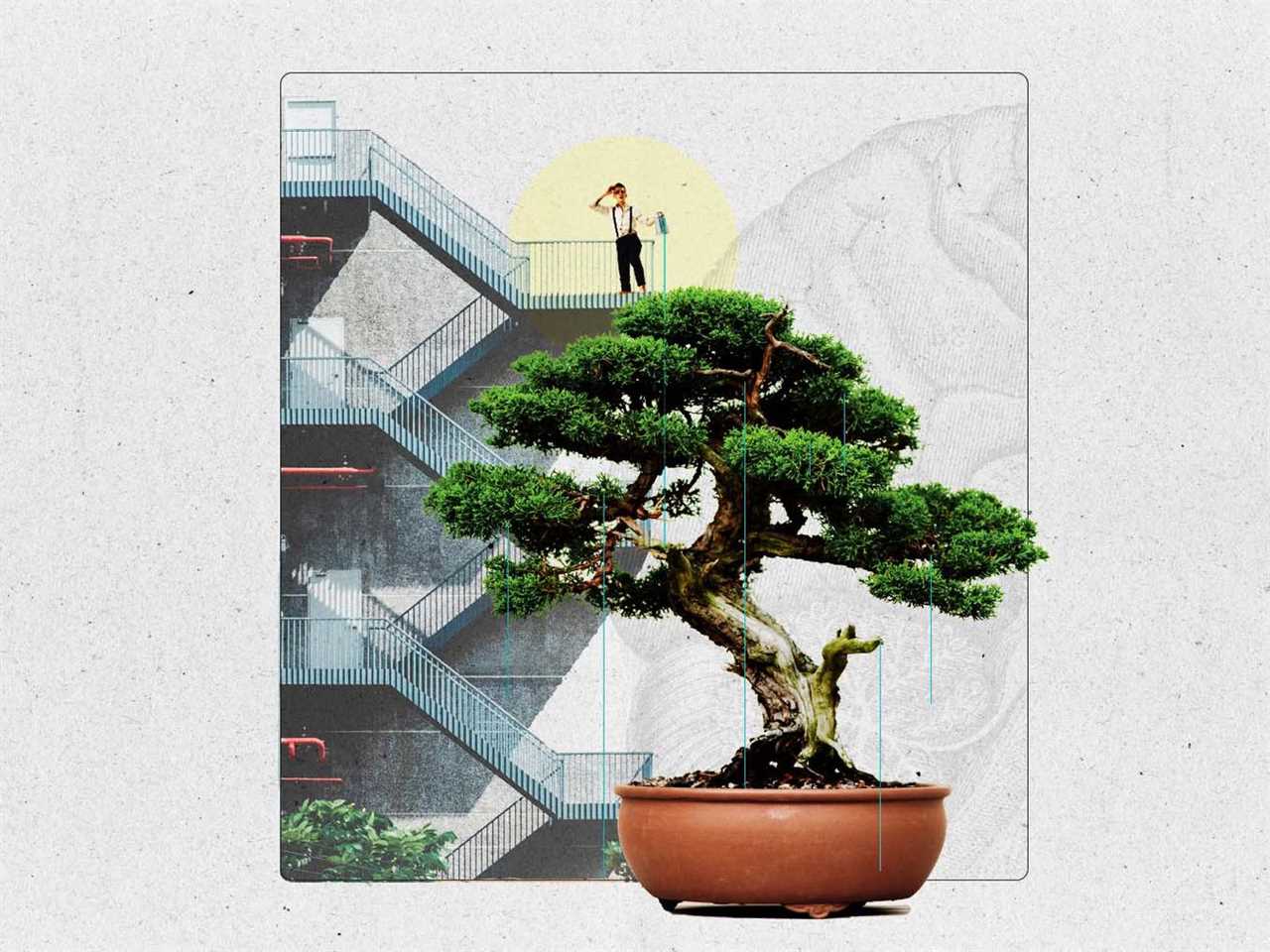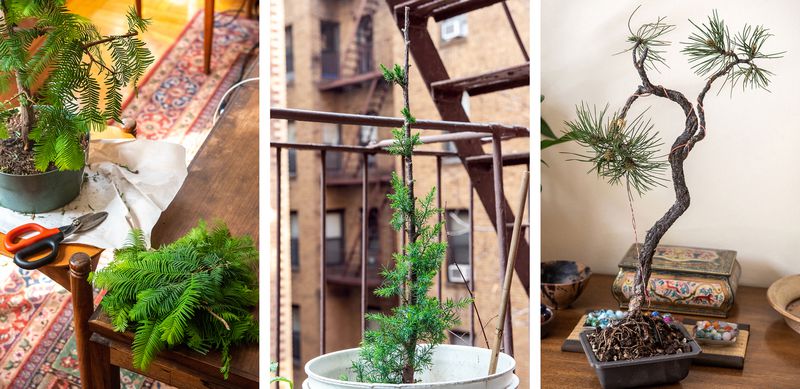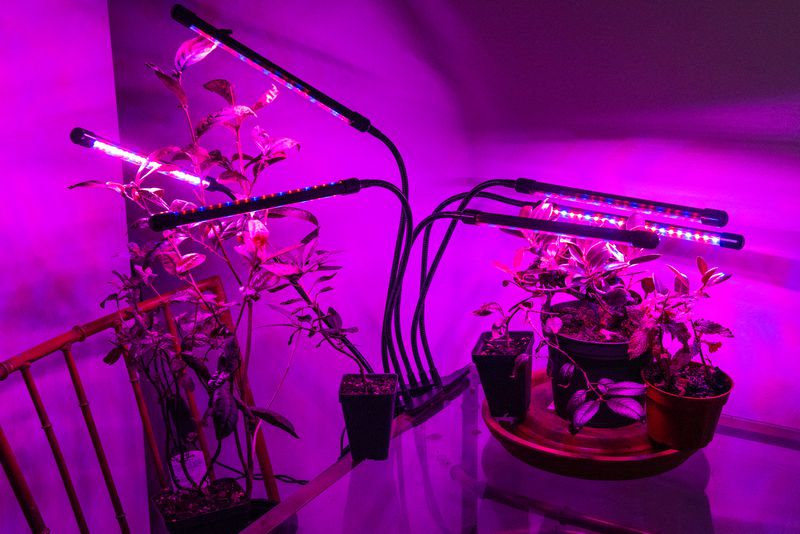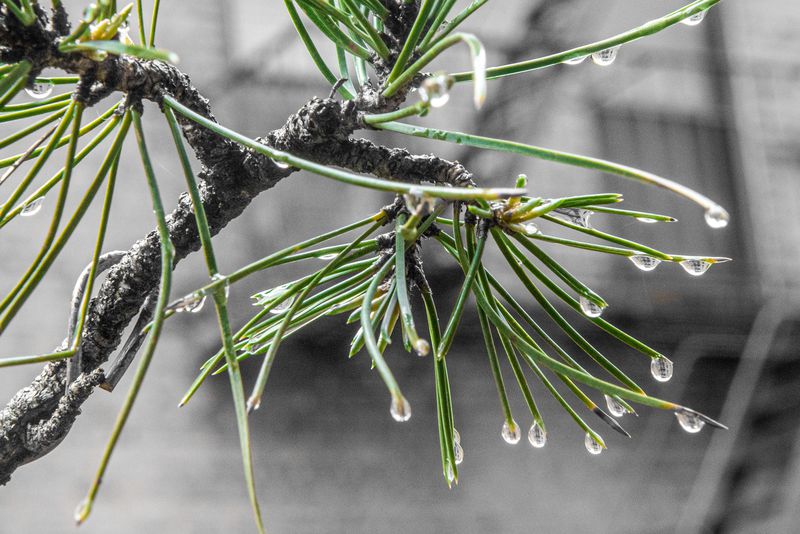
My trees need me and, in truth, I need them.
When I first started growing trees on my apartment fire escape in New York last year, I didn’t expect to mourn one of their deaths. Over the course of 2020, I bought around 20 to keep me company in a year of isolation, including a couple loblolly pines, a cute little boxwood, and the largest and priciest of the lot, a majestic four-foot deodar cedar. The cedar arrived in winter, when trees go dormant like hibernating bears, so I was waiting until spring to select branches for a design, contort them with wire, and slowly prune and style the tree into the star of my collection.
But as I did my daily check on my trees one snowy morning, I discovered the cedar had died in its sleep. The neighborhood squirrels executed it in a tactical hit that severed the trunk and tore the surrounding roots to shreds. It was a senseless and unprovoked attack, which any gardener can tell you is a squirrel’s specialty. I was despondent for weeks. Five months of studying bonsai and I had nothing to show for it save some amateurish efforts with seedlings — and now this dead cedar.
The nature of keeping plants is that they die for all kinds of reasons. But growing a tree is a promise you make to the future, and I couldn’t keep my promise for one lousy season. Maybe I should stick to houseplants, I remember thinking. It took a few more weeks to understand that my grief over the cedar was exactly why I shouldn’t — couldn’t — quit.
Bonsai is the Japanese art of making miniature trees. There’s no species called a “bonsai tree” — the word literally means “tree in a pot,” and virtually any woody tree or shrub can be trained as a bonsai. Over years and decades, you sculpt, prune, pinch, chop, and wire your little tree until it mimics a big, weathered one in nature. Pursuing bonsai can get expensive fast, but it doesn’t have to be; many bonsai begin as $20 nursery trees from Home Depot.
I first fell into bonsai after months of lockdown in one of New York City’s Covid-19 hot spots. Like a lot of people, I was losing my mind. I’ve had depression and generalized anxiety disorder for 20-odd years, and on bad days, I’m wound so tight that catastrophe lurks behind every corner, or the depression fog is so thick that summoning the energy to get out of bed takes all day. On really bad days, I’m hit with both. I’m also prone to apocalyptic thinking and have vivid, recurring nightmares about the end of the world. I don’t have suicidal thoughts, but for weeks or months at a time, I won’t feel much enthusiasm about being alive, either.
I have support systems, a great therapist, and access to effective medication, but during the pandemic, it’s been hard not to feel as though the world is coming to an end when I’m bombarded with convincing evidence that the world might, in fact, be coming to an end. So with all my extra time at home, I wanted a hobby that could improve my feelings about life and death on planet Earth. Houseplants were a start, but I craved rigor. I like meticulous hobbies: I collect specialty teas and age them in climate-controlled containers; for a while, I got into the history of vintage marbles. If it doesn’t involve a level of esoteric knowledge that might induce my brain to loosen its stranglehold on my adrenal glands, I don’t want it.
And boy, there is so much to learn about bonsai. I devoured Reddit threads and binged videos of bonsai exhibitions, where stout, gnarly maples stood alongside gravity-defying conifers that seem sculpted from a dream. One juniper in particular, by the artist Naoki Maeoka, still gives me chills with its wild ribbons of deadwood and manicured clouds of foliage. Armed with YouTube tutorials by educators like Peter Chan and Jason Chan (no relation), I practiced on cheap trees I could find at my local plant shop. “The first two branches are the welcoming branches, like your arms,” Peter Chan says while styling an Alberta spruce. “They should swing forward to embrace you.”
When my plant shop ran out of trees for me to work on, I bought more from private auctions on Facebook. My fire escape became a precarious garden. I should mention this is not legal and poses a genuine fire safety risk; after a Fire Department inspection a few months ago, I was admonished by my building and painfully forced to relocate my trees. They now live in a friendly neighborhood restaurant’s outdoor planters, where I can continue to work on them without interference.

Max Falkowitz
I wouldn’t say that bonsai is especially “fun.” Every step I take has been a stumble, and a year into this practice, I’ve only begun to parse the stylistic and horticultural differences of how bonsai is practiced in Japan, elsewhere in Asia, and the US and Europe. Different regions foster different trees, and part of the thrill of bonsai is applying its techniques to local species, as the Indian artist Manoj Kumar does with tropicals like wood-apple.
One thing they don’t tell you about bonsai is that when you make a mistake, you have to see it for however long that tree lives. Its judgment is palpable.
“My yard is slowly filling up with meaningful failures,” Tobin Mitnick tells me of the two dozen trees in his bonsai collection. Mitnick, 34, is an actor in Los Angeles who’s become a TikTok star as Jews Love Trees, a bonsai account that irreverently blends Borscht Belt comedy with searing, humanistic perspective. Most of Mitnick’s bonsai are young “sticks in pots,” he says, “but five of them have potential to be real beautiful trees that could even be shown one day. The emotional attachment starts because you realize this is a more serious tree, even if you just bought it as raw nursery stock.”
Mitnick also has obsessive-compulsive disorder, and we discussed the ways our illnesses guided us to bonsai. He fell into bonsai in 2019 and started Jews Love Trees a year later. “Trees became an addendum to the boring parts of medication and running and keeping myself creatively occupied,” he explained. “My heart rate was over 100 beats per minute for all of March and April. I was convinced I had ALS, had lots of breakdowns, was missing sleep three to four nights a week.”
Come autumn of 2019, he found himself indulging his childhood interest in trees and nature by hiking in the California mountains and examining the region’s twisted pines. Tree Instagram led him to the rabbit hole of Bonsai Instagram, and when the pandemic hit and outdoor plant nurseries were some of the only places he could visit, he took the plunge. “In therapy, they always talk about looking forward to things,” Mitnick tells me. “I’d wait for a new bonsai book in the mail the way you’d wait for a new toy when you were 9.”
Like me, Mitnick has hit walls that made him reevaluate his relationship with the pursuit. “All of my yamadori died,” he says. Yamadori refers to individual wild trees, as well as the practice of digging up and potting old trees in nature that have been twisted and dwarfed by the elements into natural bonsai. Many of the world’s great bonsai began this way, and for some, the hunt and yearslong process of nursing a wild tree back to health are almost sacred. But the failure rate is high, even for experienced practitioners; some trees never recover from transplant shock.
“I have to come to terms with the fact that I killed some very old trees, Mitnick says. “I felt disgusted with myself. You’re ripping something out of the ground that took two or three centuries to grow and all you’re thinking about is how cool this will look in your backyard.” His zeal has softened into a deeper understanding that bonsai is going to be part of his life for a while. The path will have pitfalls and will not be linear. “Part of the long haul of bonsai is coming to terms with what you can do without overreaching,” he tells me.
Bonsai is about science as much as living art. Beyond aesthetic principles, like how to develop a tapering trunk with a wide root base to communicate a sense of age, you also have to bone up on biochemistry to keep your tree alive. In nature, trees benefit from all kinds of symbiotic relationships with fungi, bacteria, and even neighboring trees as they exchange carbon and other nutrients. Ripped from its natural environment, a bonsai relies on the person who cares for it. If you want your tree to thrive, you must become its forest, recreating through artificial means what nature does by design.

Max Falkowitz
Regular potting soil will drown your tree. To provide the roots oxygen, you need a coarse, free-draining mix of porous stone and clay that looks like something you’d find at the bottom of an aquarium. The ideal composition of that soil is the subject of fierce debate; online bonsai communities love to talk about soil mixes in terms of “cation exchange capacity.” Cations — a word I haven’t heard outside of bonsai since 10th grade chemistry — are positively charged particles that affect your tree’s ability to absorb nutrients from fertilizer.
You must also become attuned to the seasonal cycles of your tree. When does it flush new growth and how much pruning can it take? Your microclimate matters too: How much sun does the tree get per day? How’s the wind and humidity? The feeling of total immersion I get from these questions — the seductive voice in the back of my head that calls me to abandon my responsibilities and dig for answers — is one of the only things that makes me feel at peace.
My trees need me and, in truth, I need them. In a year where I, a freelance writer, felt so sacked by the world that I could barely climb out of bed to write a single article, I started a free bonsai newsletter that I actually looked forward to drafting each week. There’s a concept in Zen Buddhism called shoshin, or beginner’s mind: to study without the blinders of preconceptions and assumptions. My trees and my couple hundred readers don’t ask to see bona fides. I’m free to be my bungling self.
There is a long, if tenuous, history of scholarship on the effect of plants on a person’s well-being. In 1976, researchers Ellen Langer and Judith Rodin published a study linking personal agency over houseplant care to greater longevity for seniors in nursing homes. This paper might not meet research standards today, but it sparked scientists’ interest. A 2009 study from the American Society for Horticultural Science looked at nursing home residents who took interactive group houseplant courses, choosing their own plants, pots, and soil. After a month, teachers noted that participants seemed less passive and lonely and more active and socially engaged.
When I reached out to Shelly Svoboda, a neurologist and bonsai practitioner in Corvallis, Oregon, I intended to pick her brain about this link. We did for a bit; she mentioned how weekends spent working on her trees put her into a flow state, a psychological term for effortless, energized focus that comes from being totally immersed in an activity. There are decades of research on flow’s role in performance and productivity, as well as its potential healing effect on depression and anxiety.

Max Falkowitz
But as in every conversation I’ve had with a bonsai person, Svoboda and I couldn’t help ourselves and drifted into talking about our trees. Svoboda, 63, was diagnosed with depression when she was 12. “For me, depression is the absence of interest in anything that’s not the quotidian terror inside your head,” she says.
I pause, taken aback by the accuracy of her statement. “When I started getting serious about bonsai, I was going through some shitty times,” she explains. “Looking back, it’s clear to me now that a part of me recognized that I need this.” I tell her the same is true for me.
Svoboda got seriously into bonsai four years ago by studying with the bonsai artist Ryan Neil, and by making local bonsai friends who’ve become her mentors. She currently has around 150 trees in various states of development. For her, the most intense part of bonsai isn’t digging yamadori or making drastic trunk bends, but the stretches of contemplation in between.
“One day, my husband came home and found me on the porch staring at this tree,” she tells me. “He asked what I was doing and I told him I was thinking about cutting off this one branch. An hour later he came out again. I hadn’t moved — and I was still thinking about whether to cut the branch.”
I’m still in that stare-for-an-hour place with my trees, which I’m taking the time to appreciate. Bonsai, I’m learning, is the kind of pursuit that makes me grateful to have five or six more decades on the planet. I’m not sure what my future bonsai practice will look like, but I know that there will be one, and on days of mental anguish that feel unbearable, I remind myself that my trees will still greet me for watering duty tomorrow.
Max Falkowitz is a food and travel writer from Queens. He’s also the co-author of The Dumpling Galaxy Cookbook with Helen You and the author of Taste Test: 200 Trivia Questions for Food Nerds. He sends his bonsai newsletter on Friday mornings.
----------------------------------------
By: Max Falkowitz
Title: Bonsai and the delicate art of feeling better
Sourced From: www.vox.com/22837558/bonsai-trees-pandemic-mental-health-wellness
Published Date: Fri, 17 Dec 2021 17:10:00 +0000






